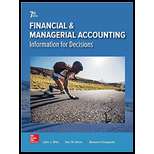
Current ratio is the ratio which is used to measure a company’s liquidity and it considers current assets and current liabilities.
Acid test ratio:
Acid test ratio is a ratio which is measures the ability of a company to pay off its current obligations out of near cash or quick assets.
Day’s sales uncollected:
Day’s sales uncollected imply how much days a company takes to collect its accounts receivables.
Inventory turnover:
Frequency of a company’s inventory sold or returned is shown by inventory turnover.
Day’s sales in inventory:
Day’s sales inventory shows the average number of days the company not selling its inventory or holding it before selling.
Debt to equity ratio:
Debt to equity ratio is a solvency ratio which indicates relative proportion of total liabilities and total equity.
Time interest earned:
Time interest earned is the ratio which reflects risk of loan repayments of vendors or creditors of with interest.
Profit margin ratio:
Profit margin ratio shows net income as a percent of sales. This ratio reflects a company’s ability of earning.
Total assets turnover ratio:
Total assets turnover ratio is the measurement of a company’s revenue or sales to its value of total assets.
Return on total assets ratio:
Measurement of a company’s earnings against its net assets is known as return on total assets ratio.
Return on common
Return on common stockholder’s equity displays returns received on stockholder’s equity for a certain period of time.
To compute: (1) current ratio, (2) acid test ratio, (3) day’s sales uncollected, (4) inventory turnover (5) day’s sales in inventory (6) debt to equity ratio (7) time interest earned (8) profit margin ratio (9) total assets turnover ratio (10) return on total assets ratio (11) return on common stockholder’s equity of S Company.
Want to see the full answer?
Check out a sample textbook solution
Chapter 13 Solutions
GEN COMBO FINANCIAL AND MANAGERIAL ACCOUNTING; CONNECT ACCESS CARD
- I am looking for the correct answer to this general accounting problem using valid accounting standards.arrow_forwardCan you help me find the accurate solution to this financial accounting problem using valid principles?arrow_forwardA company reports the following figures for the • Net income: $280,000 . Preferred dividends: $30,000 year: • • Average total stockholders' equity: $2,100,000 Average common stockholders' equity: $1,300,000 (a) The return on stockholders' equity, and (b) The return on common stockholders' equity. (Round your answers to one decimal place.)arrow_forward
- I don't need ai answer general accounting questionarrow_forwardSoza earns $1,850 per pay period. Compute the FICA taxes for both employee and employer share. What is the total of the employee- and employer-share FICA tax liabilities for Soza's pay per pay period? Note: Assume that Soza has not met the Social Security wage base.arrow_forwardI need help solving this financial accounting question with the proper methodology.arrow_forward
- General accountingarrow_forwardA company reported an increase in net sales from $5.2 billion in 2021 to $5.8 billion in 2022. During the same period, its gross profit rose from $1.6 billion in 2021 to $1.9 billion in 2022. Calculate the gross profit percentage for each year.arrow_forwardFinancial Accountingarrow_forward

 AccountingAccountingISBN:9781337272094Author:WARREN, Carl S., Reeve, James M., Duchac, Jonathan E.Publisher:Cengage Learning,
AccountingAccountingISBN:9781337272094Author:WARREN, Carl S., Reeve, James M., Duchac, Jonathan E.Publisher:Cengage Learning, Accounting Information SystemsAccountingISBN:9781337619202Author:Hall, James A.Publisher:Cengage Learning,
Accounting Information SystemsAccountingISBN:9781337619202Author:Hall, James A.Publisher:Cengage Learning, Horngren's Cost Accounting: A Managerial Emphasis...AccountingISBN:9780134475585Author:Srikant M. Datar, Madhav V. RajanPublisher:PEARSON
Horngren's Cost Accounting: A Managerial Emphasis...AccountingISBN:9780134475585Author:Srikant M. Datar, Madhav V. RajanPublisher:PEARSON Intermediate AccountingAccountingISBN:9781259722660Author:J. David Spiceland, Mark W. Nelson, Wayne M ThomasPublisher:McGraw-Hill Education
Intermediate AccountingAccountingISBN:9781259722660Author:J. David Spiceland, Mark W. Nelson, Wayne M ThomasPublisher:McGraw-Hill Education Financial and Managerial AccountingAccountingISBN:9781259726705Author:John J Wild, Ken W. Shaw, Barbara Chiappetta Fundamental Accounting PrinciplesPublisher:McGraw-Hill Education
Financial and Managerial AccountingAccountingISBN:9781259726705Author:John J Wild, Ken W. Shaw, Barbara Chiappetta Fundamental Accounting PrinciplesPublisher:McGraw-Hill Education





